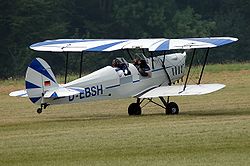
Stampe
Encyclopedia

Belgium
Belgium , officially the Kingdom of Belgium, is a federal state in Western Europe. It is a founding member of the European Union and hosts the EU's headquarters, and those of several other major international organisations such as NATO.Belgium is also a member of, or affiliated to, many...
aircraft manufacturer formed in 1922 and based at Antwerp. The company specialised in design and construction of primary trainers/tourers and advanced trainers. One of the products - the Stampe SV.4
Stampe SV.4
-Bibliography:* Pacco, John. "Stampe & Vertongen SV-4B" Belgisch Leger/Armee Belge: Het Militair Vliegwezen/l'Aeronautique Militaire 1930-1940. Aartselaar, Belgium, 2003, pp. 85-86. ISBN 90-801136-6-2....
- has become well known as just Stampe.
History
Established in 1922 with Alfred RenardAlfred Renard
-Biography:Alfred Renard was born in Anderlecht on 21 April 1895. Already as a youngster, inspired by kites he saw his father make, he illustrated his technical ability by installing electricity and telephone at an uncle's farm....
as its Chief Designer, the company designed a series of trainer/tourer aircraft in the 1920s and 1930s, all prefixed RSV (for Renard, Stampe and Vertongen). In the early 1930s Alfred Renard left to join a company he had formed with his brother Georges Renard Société Anonyme d'Avions et de Moteurs Renard. The RSV company designation prefix then changed to SV. The company's most successful design was the SV.4
Stampe SV.4
-Bibliography:* Pacco, John. "Stampe & Vertongen SV-4B" Belgisch Leger/Armee Belge: Het Militair Vliegwezen/l'Aeronautique Militaire 1930-1940. Aartselaar, Belgium, 2003, pp. 85-86. ISBN 90-801136-6-2....
of 1933, a light tourer/trainer biplane powered by a de Havilland Gipsy III engine. Although only 35 were produced before the start of the war, a total of 940 were built, mainly under licence by other companies.
The company was renamed Stampe et Renard when Stampe merged with the Renard company. Owing to the German invasion production ceased on 10 May 1940. Post-war activities did not meet with much success.
Aircraft
- RSV.32-90 trainer biplane (variants: RSV.32-100, RSV.32-105, RSV.32-110, RSV.32-120, RSV.32-130)
- RSV.26-140 trainer biplane (variants: RSV.26-180, RSV.26-Lynx)
- RSV.20-100 parasol-wing monoplane
- RSV.23-180 trainer biplane
- RSV.22-180 trainer biplane (variant: RSV.22-200)
- RSV.28-180 advanced trainer biplane
- RSV.22-Lynx advanced trainer biplane
- RSV.22-Titan military biplane
- RSV.26-100 trainer/tourer biplane, convertible into a monoplane (variants: RSV.18-100, RSV.18-105)
- SV.4 trainer/tourer biplane
- SV.5 military training biplane
- SV.7 reconnaissance-bomber
- SV.10 biplane bomber
- SV.18 lightweight parasol wing monoplane

